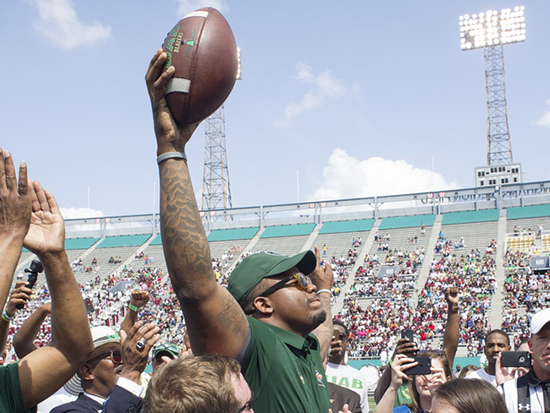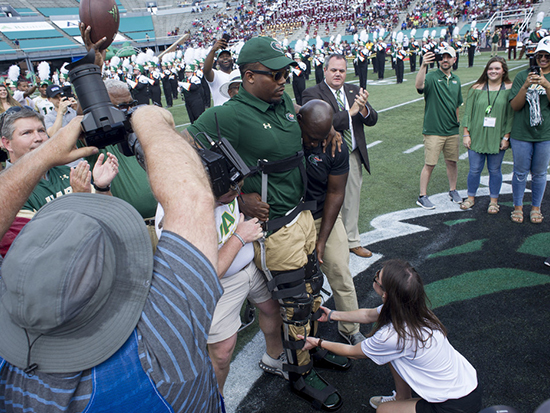A viral video introduced University of Alabama at Birmingham alumnus Tim Alexander to the world when the paralyzed former football player stood from his wheelchair to deliver the game ball in the Blazers’ return to action. What many people did not see was the hard work and determination Alexander showed for a decade to reach that moment.
Alexander is a busy man, traveling the country inspiring others in addition to working as director of Character Development for the UAB Blazers football team.
 Tim Alexander delivered the game ball prior to the Blazers' first game of the 2017 season.Ten years ago, Alexander was a star football player at Erwin High School in Center Point, Alabama, and confident he could play college football at any school in the country. But in October 2006, tragedy struck as Alexander fell victim to a car crash after a driver fell asleep at the wheel.
Tim Alexander delivered the game ball prior to the Blazers' first game of the 2017 season.Ten years ago, Alexander was a star football player at Erwin High School in Center Point, Alabama, and confident he could play college football at any school in the country. But in October 2006, tragedy struck as Alexander fell victim to a car crash after a driver fell asleep at the wheel.
“I became paralyzed instantly,” Alexander said. “My friend asked, ‘Is everyone OK?’ I said, ‘No. I can’t feel my legs.’”
Paralyzed from the neck down, Alexander also suffered from traumatic brain injury and lost the ability to communicate orally and in written form. While he eventually gained those functions back, it seemed that all hope of having what he thought was a normal life was lost. Alexander says that after the accident he struggled with depression and even had suicidal thoughts.
“I was just ready to give up,” he said. “I had gone from being a good athlete to being cared for like a baby. That just wasn’t for me.”
Through all the pain, the heartache and struggle, Alexander says, he did not like the man he had become, and decided to change.
“Everybody has a moment,” he said. “I had a dream of playing ball at UAB and just went after that dream.”
Alexander’s association with Blazer football began in 2012. A year after he enrolled at UAB, he convinced then-head coach Garrick McGee to make him an honorary player. For the next three years, including after Bill Clark became head coach in 2014, Alexander followed the same schedule as the other players, working out with them in the weight room and taking what he calls “mental reps” on the practice field. He even got a locker and a jersey.
After the announcement that three athletics programs, including football, were shutting down in 2014, Alexander became a champion for the return of those programs. Thanks in part to his tireless efforts, football was reinstated and now has more fan and financial support, and more momentum than ever before.
“One of my trainers told me, ‘If you believe something can happen, then “no” is not an option.’ That’s always stuck with me,” Alexander said. “So, I never doubted. I knew, if we did what we had to do, then football would be back.”
Football was not the only thing that was returning.
On Sept. 2, Blazer football kicked off its return, after two seasons away, against Alabama A&M. Twenty minutes prior to the game, Alexander joined many of his 2014 teammates on the field in front of more than 45,000 screaming fans. Only this time he was not in a wheelchair.
He was walking. Even for just a few moments, and with assistance from his physical therapy team, he was walking.
Over the course of the last six months, Alexander and his trainer of more than two years, Natalie Shannon of Drayer Physical Therapy, a UAB School of Health Professions alumna, have been working behind the scenes to prepare him for UAB football’s return and his own.
 Natalie Shannon (below) has been Alexander's therapist for the last two years.Shannon and Alexander first met after her mother saw a local television report on his recovery. Shannon was heading to a tailgate party at an Erwin High School football game — Alexander’s alma mater — and reached out to Alexander via the internet. They met up at the tailgate, where she offered her physical therapy expertise to help him in his goal to eventually walk again.
Natalie Shannon (below) has been Alexander's therapist for the last two years.Shannon and Alexander first met after her mother saw a local television report on his recovery. Shannon was heading to a tailgate party at an Erwin High School football game — Alexander’s alma mater — and reached out to Alexander via the internet. They met up at the tailgate, where she offered her physical therapy expertise to help him in his goal to eventually walk again.
“I always say God worked things out so we could meet,” Shannon said.
Many hours and much sweat were poured into a strict training regimen, but Alexander says it was worth it. Alexander’s current therapy sessions begin with stretching every muscle in his body. Afterward, he is fitted with a special brace that extends from his chest to his feet that stabilizes his body and allows support while he works out on an anti-gravity treadmill, which takes the weight off his legs while he learns to walk — difficult and exhausting work, but not a problem for him.
Alexander likes to say he does not need things to be easy. He just needs them to be possible, and that is his mentality in his ultimate goal to walk again on his own.
“That’s the only way,” he said. “If you can believe it, you can achieve it, and that’s real.”
Click here to read more about Tim Alexander in UAB Magazine.